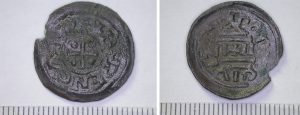Under the nEU-Med project, the indexing of the numismatic finds from the two archaeological excavations of Vetricella and Carlappiano has been completed, while we are still awaiting the results of the latest metallographic analyses; these will allow for the measurement of the specific isotopes present within the alloys used for minting the aforementioned coins, thus allowing for the identification of the potential areas for mining the minting metals.
The coins found at the Vetricella site, which cover a time span ranging from the last quarter of the 9th century to the start of the 11th century, are of considerable numismatic interest.
Overall there are sixteen silver exemplars in a good state of preservation, most of which are from the Pavia mint (11 pieces), with a lesser number from the Lucca mint (5 pieces). Nine specimens are attributable to the King of Italy and the Marquis of Pisa; four were issued in the name of Ottone, and two were issued in the name of Corrado II of Franconia.
Alongside the indexing of the new materials obtained from the excavations, all the numismatic materials from the settlements in question were also reorganized and surveyed, especially those relating to the time frame of the study itself (7th-12th cent.). The survey was followed by an examination of the archaeological and numismatic finds for Tuscany, in order to proceed with the identification of the specific pathways for the money in circulation during the 9th to 11th centuries: the acquisition of quantitative, typological and provenance data has allowed for the preparation of chrono-typological distribution maps, which can be used to interpret the numismatic and economic data.
The new numismatic database is currently being elaborated.




